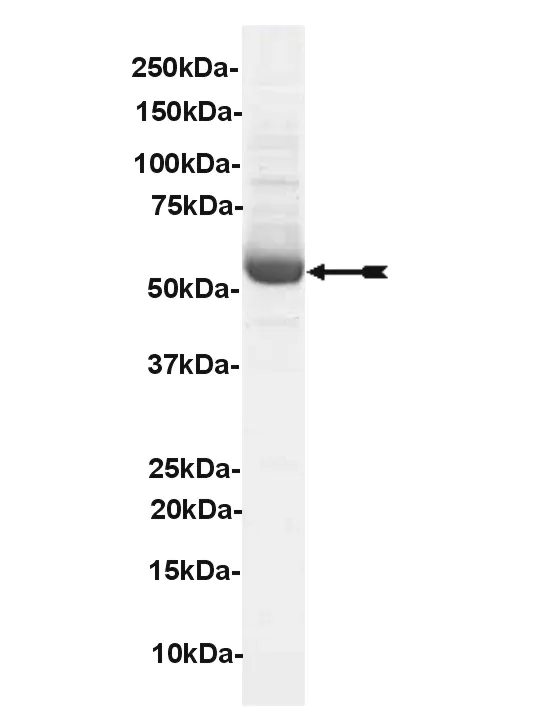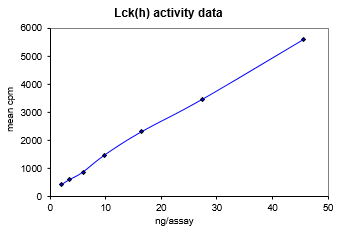Lck, active Human Recombinant Kinase Protein
N-terminal 6His-tagged recombinant, human full length Lck.
Biological information
Background
The lck protooncogene is a member of the src-related gene family of non-receptor tyrosine kinases. It is uniquely expressed only in T-lymphocytes and NK-cells. The p56lck kinase (LCK) is a 56 KD polypeptide that is associated with a cytoplasmic face of the plasma membrane. It functions as a critical signalling model in IL-2 signal transduction leading to T-lymphocyte activation. Specifically, it has been shown that a stable complex exists between IL-2 receptors and p56lck and that treatment of T-lymphocytes with IL-2 promotes p56lck kinase activity and rapid phosphorylation of cellular substrates. In addition, p56lck has been found to function as a signal transducer for antigen activated CD4 and CG8 T-cell receptors and plays a role in thymic maturation of certain T-cells. The CD45 antigen, a receptor/protein tyrosine phosphatase of T-cells, also interacts with p56lck.
Target class
Kinase
Family
TK
Accession number
NM_001042771.1; NM_005356.3
Target Name
Lck, active Human Recombinant Kinase Protein
Target Alias
LCK, p56lck, YT16, pp58lck, p56-LCK, LSK
Origin
Human
Theori. MW
59 kDa
Affinity tag
6His
Product specifications
Expression system
Expressed by baculovirus in Sf21 insect cells
Purity
Refer to CoA for Purity
Purification method
Ni2+/NTA-agarose
Sample Buffer
Specified activity
Refer to CoA
Application
For Research Only
Storage conditions
6 months at -70°C
Usage disclaimer
For Research Only
Chemical data
Background
The lck protooncogene is a member of the src-related gene family of non-receptor tyrosine kinases. It is uniquely expressed only in T-lymphocytes and NK-cells. The p56lck kinase (LCK) is a 56 KD polypeptide that is associated with a cytoplasmic face of the plasma membrane. It functions as a critical signalling model in IL-2 signal transduction leading to T-lymphocyte activation. Specifically, it has been shown that a stable complex exists between IL-2 receptors and p56lck and that treatment of T-lymphocytes with IL-2 promotes p56lck kinase activity and rapid phosphorylation of cellular substrates. In addition, p56lck has been found to function as a signal transducer for antigen activated CD4 and CG8 T-cell receptors and plays a role in thymic maturation of certain T-cells. The CD45 antigen, a receptor/protein tyrosine phosphatase of T-cells, also interacts with p56lck.
Compound name
Kinase
Catalog number
14-442
Molecular formula
CAS
MW
Ka
Percent composition
Product specifications
Physical state
Purity (HPLC 214nm)
Retention time (RP18 HPLC)
CMC
Exact mass
Stability
For Research Only
Solubility structure
Kinase Activity Assay Biological information
Background
The lck protooncogene is a member of the src-related gene family of non-receptor tyrosine kinases. It is uniquely expressed only in T-lymphocytes and NK-cells. The p56lck kinase (LCK) is a 56 KD polypeptide that is associated with a cytoplasmic face of the plasma membrane. It functions as a critical signalling model in IL-2 signal transduction leading to T-lymphocyte activation. Specifically, it has been shown that a stable complex exists between IL-2 receptors and p56lck and that treatment of T-lymphocytes with IL-2 promotes p56lck kinase activity and rapid phosphorylation of cellular substrates. In addition, p56lck has been found to function as a signal transducer for antigen activated CD4 and CG8 T-cell receptors and plays a role in thymic maturation of certain T-cells. The CD45 antigen, a receptor/protein tyrosine phosphatase of T-cells, also interacts with p56lck.
Target class
Kinase
Family
TK
Subfamily
Protein Name
Lck
Protein Alias
LCK, p56lck, YT16, pp58lck, p56-LCK, LSK
Accession Number
NM_001042771.1; NM_005356.3
UniProt Number
Gene Name
Gene ID
Gene Aliases
Target Species
Human
Kinase Activity Assay Usage
Product Type
Application
Storage Conditions
6 months at -70°C
Usage disclaimer
Kinase Activity Assay Information
Assay Type
Assay Measures
Biological Information
Background
The lck protooncogene is a member of the src-related gene family of non-receptor tyrosine kinases. It is uniquely expressed only in T-lymphocytes and NK-cells. The p56lck kinase (LCK) is a 56 KD polypeptide that is associated with a cytoplasmic face of the plasma membrane. It functions as a critical signalling model in IL-2 signal transduction leading to T-lymphocyte activation. Specifically, it has been shown that a stable complex exists between IL-2 receptors and p56lck and that treatment of T-lymphocytes with IL-2 promotes p56lck kinase activity and rapid phosphorylation of cellular substrates. In addition, p56lck has been found to function as a signal transducer for antigen activated CD4 and CG8 T-cell receptors and plays a role in thymic maturation of certain T-cells. The CD45 antigen, a receptor/protein tyrosine phosphatase of T-cells, also interacts with p56lck.
Target class
Kinase
Family
TK
Accession Number
NM_001042771.1; NM_005356.3
Target Name
Lck
Target Alias
LCK, p56lck, YT16, pp58lck, p56-LCK, LSK
Origin
Human
Theoretical MW
Affinity Tag
6His
Product Specifications
Expression system
Expressed by baculovirus in Sf21 insect cells
Purity
Refer to CoA for Purity
Purification method
Ni2+/NTA-agarose
Sample Buffer
Specified activity
Refer to CoA
Application
Storage conditions
6 months at -70°C
Usage disclaimer
For Research Only
Biological Information
Background
The lck protooncogene is a member of the src-related gene family of non-receptor tyrosine kinases. It is uniquely expressed only in T-lymphocytes and NK-cells. The p56lck kinase (LCK) is a 56 KD polypeptide that is associated with a cytoplasmic face of the plasma membrane. It functions as a critical signalling model in IL-2 signal transduction leading to T-lymphocyte activation. Specifically, it has been shown that a stable complex exists between IL-2 receptors and p56lck and that treatment of T-lymphocytes with IL-2 promotes p56lck kinase activity and rapid phosphorylation of cellular substrates. In addition, p56lck has been found to function as a signal transducer for antigen activated CD4 and CG8 T-cell receptors and plays a role in thymic maturation of certain T-cells. The CD45 antigen, a receptor/protein tyrosine phosphatase of T-cells, also interacts with p56lck.
Target class
Kinase
Family
TK
Accession Number
NM_001042771.1; NM_005356.3
Target Name
Lck
Target Alias
LCK, p56lck, YT16, pp58lck, p56-LCK, LSK
Origin
Human
Theoretical MW
Affinity Tag
6His
Product Specifications
Expression system
Expressed by baculovirus in Sf21 insect cells
Purity
Refer to CoA for Purity
Purification method
Ni2+/NTA-agarose
Sample Buffer
Specified activity
Refer to CoA
Application
Storage conditions
6 months at -70°C
Usage disclaimer
For Research Only





